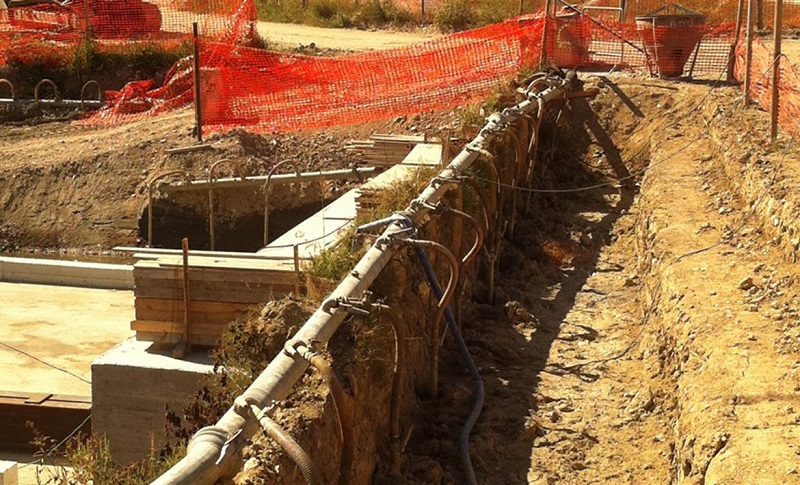Wellpoint
A wellpoint, also known as a drive point, is a small diameter well used for dewatering. It consists of a shallow shaft, a dewatering pump to draw water, a riser pipe which connects the wellpoint to the surface, and a small ‘well’ that fills up.
The riser pipes tend to be around 38-50 mm in diameter, with slots or openings at the bottom which enable water to be drawn up using the pump. The size of the openings is determined by the relative grain size of the water-bearing formation material. The openings should be large enough to allow water to enter the tube, but small enough to keep the water-bearing formation in place.
The riser pipe is often connected to a common header main pipe through a flexbow. This flexbow incorporates an adjustable valve which serves two purposes: firstly, it controls the flow of air and water entering the system; and secondly, allows a clear view of what is being pumped. The header main pipe is then connected to a wellpoint dewatering pump.
Wellpoints are fairly versatile and can be used for a wide range of applications. They are suitable for shallow foundations and trench works, particularly for long pipeline trenches where wellpoints may be installed in parallel by special trenching machines.
They can also be used for the irrigation of small to medium-sized residential gardens. If the water yield from one well is not sufficient for running an irrigation system, a second can be installed and connected to the first, enabling them to operate as one system.
They can also be used around the perimeter of excavations as an alternative to boreholes, as a means of lowering and controlling groundwater levels. They can be more cost- and time-efficient than a borehole due to the shallower depths required. In appropriate ground conditions, a wellpoint system can be installed very quickly. Traditional drilling techniques, such as jetting or auguring are typically used for installation.
Wellpoints tend not to yield large quantities of water – around 5 gallons per minute is typical. There is generally a limit of about 5-6 m in height over which water can be drawn as the vacuum is limited in practice to 0 bar. However, a second stage of wellpoints can be installed at a lower level if greater depths are required. They are capable of dealing with very low flows in silty sands as well as much larger flows in coarse sands and gravel.
Some of the benefits of using wellpoints include:
- Quick installation in most ground conditions.
- Easy to maintain.
- Capable of being used for both large and small-scale projects.
- Self-jetting wellpoints can be used in situations where there is limited space.
[edit] Find out more
[edit] Related articles on Designing Buildings Wiki
Featured articles and news
RTPI leader to become new CIOB Chief Executive Officer
Dr Victoria Hills MRTPI, FICE to take over after Caroline Gumble’s departure.
Social and affordable housing, a long term plan for delivery
The “Delivering a Decade of Renewal for Social and Affordable Housing” strategy sets out future path.
A change to adoptive architecture
Effects of global weather warming on architectural detailing, material choice and human interaction.
The proposed publicly owned and backed subsidiary of Homes England, to facilitate new homes.
How big is the problem and what can we do to mitigate the effects?
Overheating guidance and tools for building designers
A number of cool guides to help with the heat.
The UK's Modern Industrial Strategy: A 10 year plan
Previous consultation criticism, current key elements and general support with some persisting reservations.
Building Safety Regulator reforms
New roles, new staff and a new fast track service pave the way for a single construction regulator.
Architectural Technologist CPDs and Communications
CIAT CPD… and how you can do it!
Cooling centres and cool spaces
Managing extreme heat in cities by directing the public to places for heat stress relief and water sources.
Winter gardens: A brief history and warm variations
Extending the season with glass in different forms and terms.
Restoring Great Yarmouth's Winter Gardens
Transforming one of the least sustainable constructions imaginable.
Construction Skills Mission Board launch sector drive
Newly formed government and industry collaboration set strategy for recruiting an additional 100,000 construction workers a year.
New Architects Code comes into effect in September 2025
ARB Architects Code of Conduct and Practice available with ongoing consultation regarding guidance.
Welsh Skills Body (Medr) launches ambitious plan
The new skills body brings together funding and regulation of tertiary education and research for the devolved nation.
Paul Gandy FCIOB announced as next CIOB President
Former Tilbury Douglas CEO takes helm.
UK Infrastructure: A 10 Year Strategy. In brief with reactions
With the National Infrastructure and Service Transformation Authority (NISTA).
























Comments